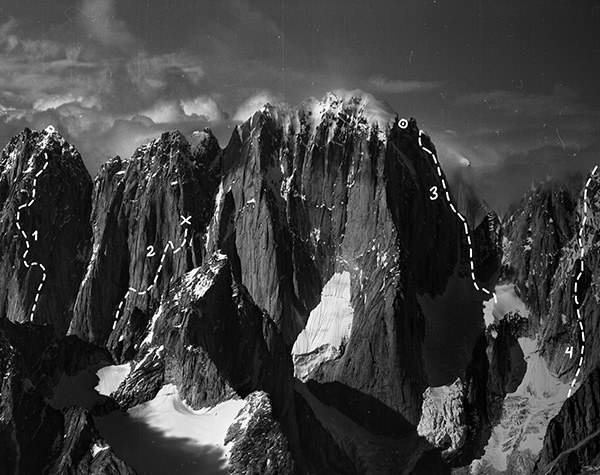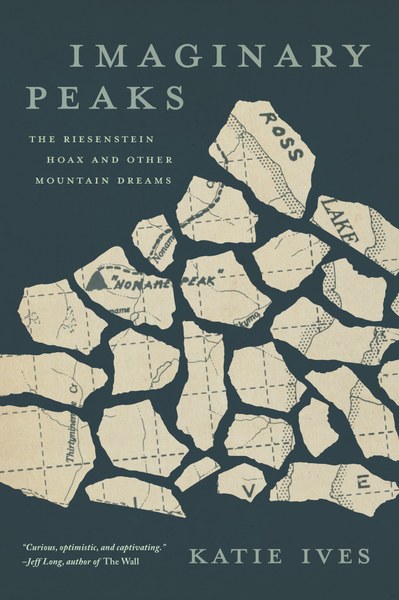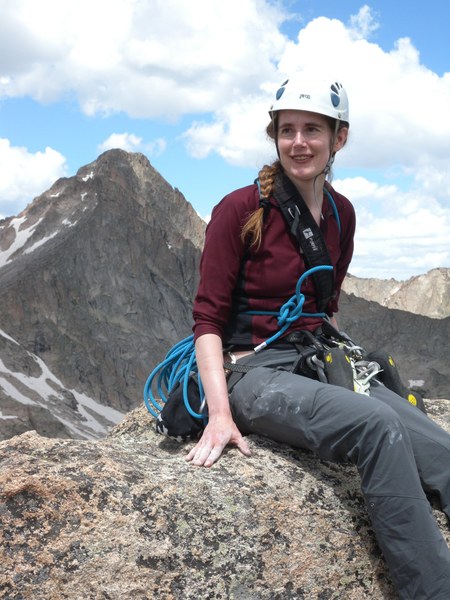
Katie Ives is editor in chief at Alpinist magazine and a well-known figure in mountain literature. Her debut book, Imaginary Peaks: The Riesenstein Hoax and Other Mountain Dreams (Mountaineers Books, October 2021), is a true tale of mountain adventure and mystery that uses an infamous deception about a fake mountain range as a lens to explore the fascination with wild places and the lure of supposedly blank spaces on the map.
The story ranges from the history of mountain myths and climbers’ preoccupation with first ascents, to the complex motivations of the men who plotted the hoax. This includes Harvey Manning, who was one of the most influential and eccentric conservation writers in the Northwest, as well as a prominent member of The Mountaineers and the editorial committee chair for the first edition of Mountaineering: The Freedom of the Hills.

What first intrigued you about the Riesenstein Hoax and made you want to learn more?
Why were you drawn to write this book? I first came across the story of the imaginary Riesenstein spires in Andy Selters’ book Ways to the Sky: A Historical Guide to North American Mountaineering. Since childhood, I’d had recurring dreams of an invisible high mountain rising from the lowlands of my Massachusetts hometown. Years later, I learned that the nineteenth-century philosopher Henry David Thoreau, who once lived just a few miles from my house, had explored a similar peak, night after night, in his sleep. Something about fantasy summits seems to embody powerful, inchoate longings in many people’s minds. And I wanted to gain a better understanding of this persistent allure.
What’s the most surprising thing you learned while working on this book?
When I began my research, I’d only heard about the Riesenstein Hoax. It was a surprise for me to learn that it was only one of several climbing hoaxes designed by Harvey Manning. It was even more of a surprise to find some humorous letters between Harvey and his friends — in which they’d discussed a few of these elaborate plots — still carefully preserved, tucked away in boxes in the University of Washington Libraries Special Collections.
Tell us what it was like to research and write about noted Mountaineer Harvey Manning.
Harvey had saved an astounding amount of his letters, notebooks, and manuscripts — including mere scraps of paper on which he’d jotted down passing ideas. Pieced together, these documents seemed to me like a giant treasure map, suggesting countless ideas for quests to fabulous peaks, both real and imaginary. Before the start of the pandemic, I was able to retrace, on foot, some of Harvey’s actual wanderings. During the best of these adventures, I followed a map that his son, Paul, had drawn for me to an unmarked Cascades trail, over a steep pass and through the space between two evergreens that seemed like a portal to another world. There, I found myself in Harvey’s favorite alpine basin, surrounded by radiant wildflowers, a snowy dome, and an outer rim of peaks that resembled the walls of a sanctuary. It was like one of the mythic realms that Harvey (and others like him) wrote about, but this one was actually real.
 Katie Ives. Photo by Chris Weidner.
Katie Ives. Photo by Chris Weidner.
How do you think place influenced this story?
The landscapes of the Pacific Northwest, particularly the North Cascades, tend to encourage an awareness of the complexities of exploration history and the possibilities of myth: the many Indigenous and non-Indigenous stories that layer the mountains; the tangles of devil's club, vine maple, and slide alder that form barriers to both climbers and early mapmakers; the dense forests of moss-strung trees that appear enchanted with age, mystery, and shadows; the convoluted topographies that conceal lush alpine basins. All of these elements, I think, helped inspire Harvey Manning’s dreams of hidden wonderlands.
What do you hope readers take away from this book?
Like the creators of the Riesenstein Hoax, I hope to inspire readers to look more critically and creatively at preconceptions of the “wild,” at obsessions with claims of first ascents, and at other assumptions that often shape dominant accounts of climbing history. I also hope to encourage readers to see the potential of the imagination in re-envisioning mountain geographies and in supporting more inclusive ways of approaching cartography and storytelling. As Joan Aiken once wrote, “Why do we want to have alternate worlds? It’s a way of making progress. You have to imagine something before you do it.”
If you were going to orchestrate a hoax, what would it be?
If I told you now, my friends and I wouldn’t be able to pull off the hoax later.
Imaginary Peaks is available for purchase at our Seattle Program Center bookstore, online at mountaineersbooks.org, and anywhere books are sold.
This article originally appeared in our Winter 2022 issue of Mountaineer Magazine. To view the original article in magazine form and read more stories from our publication, visit our magazine archive.
 The Mountaineers
The Mountaineers